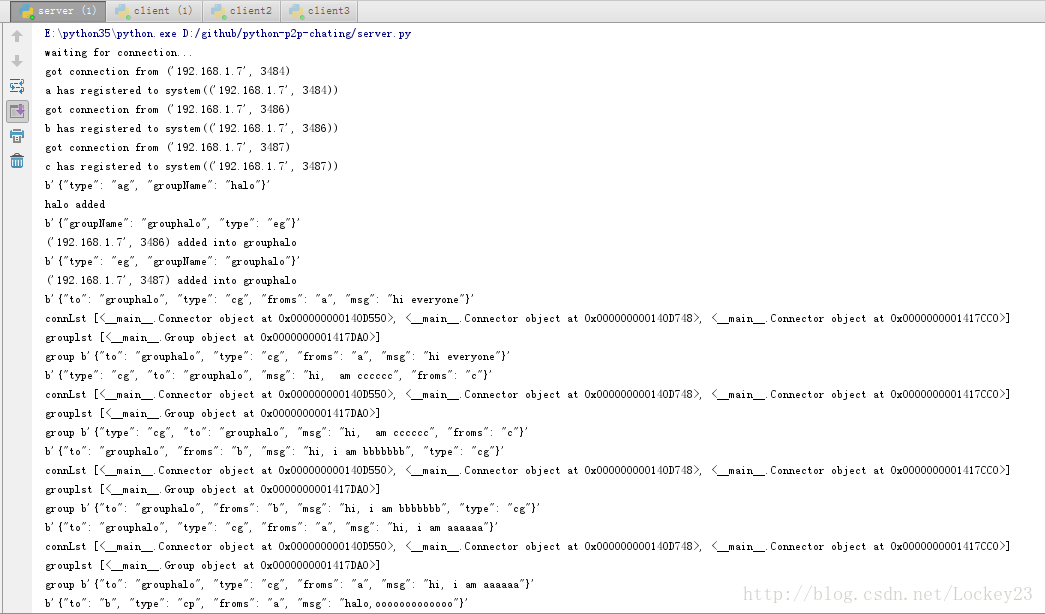Python unittest单元测试框架总结
什么是单元测试
单元测试是用来对一个模块、一个函数或者一个类来进行正确性检验的测试工作。
比如对于函数abs(),我们可以编写的测试用例为:
(1)输入正数,比如1、1.2、0.99,期待返回值与输入相同
(2)输入复数,比如-1、-1.2、-0.99,期待返回值与输入相反
(3)输入0,期待返回0
(4)输入非数值类型,比如None、[]、{}、期待抛出TypeError
把上面这些测试用例放到一个测试模块里,就是一个完整的单元测试
unittest工作原理
unittest中最核心的四部分是:TestCase,TestSuite,TestRunner,TestFixture
(1)一个TestCase的实例就是一个测试用例。测试用例就是指一个完整的测试流程,包括测试前准备环境的搭建(setUp),执行测试代码(run),以及测试后环境的还原(tearDown)。元测试(unit test)的本质也就在这里,一个测试用例是一个完整的测试单元,通过运行这个测试单元,可以对某一个问题进行验证。
(2)而多个测试用例集合在一起,就是TestSuite,而且TestSuite也可以嵌套TestSuite。
(3)TestLoader是用来加载TestCase到TestSuite中的。
(4)TextTestRunner是来执行测试用例的,其中的run(test)会执行TestSuite/TestCase中的run(result)方法
(5)测试的结果会保存到TextTestResult实例中,包括运行了多少测试用例,成功了多少,失败了多少等信息。
综上,整个流程就是首先要写好TestCase,然后由TestLoader加载TestCase到TestSuite,然后由TextTestRunner来运行TestSuite,运行的结果保存在TextTestResult中,整个过程集成在unittest.main模块中。
python unittest简介
unittest是python下的单元测试框架,是java JUnit的python版本, 跟其它语言下的单元测试框架风格类似,unittest支持自动化测试、共享setup和teardown代码、测试聚合成集、独立于报告框架。unittest模块提供了一个丰富的工具集用于构建和执行用例,先看一个入门的例子:
import unittest
class TestStringMethods(unittest.TestCase):
def test_upper(self):
self.assertEqual('foo'.upper(), 'FOO')
def test_isupper(self):
self.assertTrue('FOO'.isupper())
self.assertFalse('Foo'.isupper())
def test_split(self):
s = 'hello world'
self.assertEqual(s.split(), ['hello', 'world'])
# check that s.split fails when the separator is not a string
with self.assertRaises(TypeError):
s.split(2)
if __name__ == '__main__':
unittest.main()
可以通过继承unittest.TestCase创建一个测试用例TestStringMethods,在这个用例中定义了测试函数,这些函数名字都以”test”开头,在执行测试用例TestStringMethods时,这些方法会被自动调用。每个测试函数中都调用了assertTrue()和assertFalse()方法检查预期结果,或者使用assertRaises()确认产生了一个特定异常。现在来看一下这段代码的运行结果:
...
----------------------------------------------------------------------
Ran 3 tests in 0.000sOK
有时我们需要在用例执行前后做一些工作如初始化和清理,这就需要实现setUp()和tearDown()方法
import unittest
class WidgetTestCase(unittest.TestCase):
def setUp(self):
print("setUp()")
def test_1(self):
print("test_1")
def test_2(self):
print("test_2")
def tearDown(self):
print("tearDown()")
if __name__ == '__main__':
unittest.main()
运行结果:
setUp()
.test_1
tearDown()
setUp()
.test_2
tearDown()
----------------------------------------------------------------------
Ran 2 tests in 0.000sOK
注:如果setUp()执行成功(没有异常发生),那么无论测试方法是否通过,tearDown()都会被执行
根据所测的特性测试用例被组合在一起,通过调用unittest.main(),unittest测试框架会自动收集所有模块的测试用例然后执行。
import unittest
class WidgetTestCase(unittest.TestCase):
def setUp(self):
print("WidgetTestCase setUp()")
def test_Widget(self):
print("test_Widget")
def tearDown(self):
print("WidgetTestCase tearDown()")
class FuncTestCase(unittest.TestCase):
def setUp(self):
print("FuncTestCase setUp()")
def test_func(self):
print("test_func")
def tearDown(self):
print("FuncTestCase tearDown()")
if __name__ == '__main__':
unittest.main()
运行结果:
FuncTestCase setUp()
test_func
FuncTestCase tearDown()
.WidgetTestCase setUp()
test_Widget
WidgetTestCase tearDown()
.
----------------------------------------------------------------------
Ran 2 tests in 0.003sOK
如果想构建自已的用例集,只需要这么做:
import unittest
class WidgetTestCase(unittest.TestCase):
def setUp(self):
print("WidgetTestCase setUp()")
def test_Widget(self):
print("test_Widget")
def tearDown(self):
print("WidgetTestCase tearDown()")
class FuncTestCase(unittest.TestCase):
def setUp(self):
print("FuncTestCase setUp()")
def test_func(self):
print("test_func")
def tearDown(self):
print("FuncTestCase tearDown()")
def suite():
suite = unittest.TestSuite()
suite.addTest(FuncTestCase('test_func'))
return suite
if __name__ == '__main__':
runner=unittest.TextTestRunner()
runner.run(suite())
运行结果:
FuncTestCase setUp()
test_func
FuncTestCase tearDown()
.
----------------------------------------------------------------------
Ran 1 test in 0.001sOK
unittest中相关类和函数
在unittest中 TestCase类的实例代表逻辑测试单元,这个类通常被当作测试类的基类使用, TestCase类实现了许多测试相关的接口,主要是以下三组方法:
1.执行测试用例的方法
setUp() #在每个测试方法之前执行,这个方法引发的异常会被认为是错误,而非测试失败,默认实现是不做任何事 tearDown() #在每个测试方法之后执行,即使测试方法抛出异常tearDown()方法仍会执行,并且只有setUp()成功执行时tearDown()才会执行, #同样这个方法引发的异常会被认为是错误,而非测试失败。默认实现是不做任何事 setUpClass() #在一个测试类的所有测试方法执行之前执行,相当于google test中的SetUpTestCase()方法,setUpClass()必须被装饰成一个classmethod() @classmethod def setUpClass(cls): ... tearDownClass() #在一个测试类的所有测试方法执行之后执行,相当于google test中的TearDownTestCase()方法,tearDownClass()必须被装饰成一个classmethod() @classmethod def tearDownClass(cls): ...
2.检查条件和报告错误的方法
| Method | Checks that | New in |
|---|---|---|
| assertEqual(a, b) | a == b | |
| assertNotEqual(a, b) | a != b | |
| assertTrue(x) | bool(x) is True | |
| assertFalse(x) | bool(x) is False | |
| assertIs(a, b) | a is b | 3.1 |
| assertIsNot(a, b) | a is not b | 3.1 |
| assertIsNone(x) | x is None | 3.1 |
| assertIsNotNone(x) | x is not None | 3.1 |
| assertIn(a, b) | a in b | 3.1 |
| assertNotIn(a, b) | a not in b | 3.1 |
| assertIsInstance(a, b) | isinstance(a, b) | 3.2 |
| assertNotIsInstance(a, b) | not isinstance(a, b) | 3.2 |
| assertRaises(exc, fun, *args, **kwds) | fun(*args, **kwds) raises exc | |
| assertRaisesRegex(exc, r, fun, *args, **kwds) | fun(*args, **kwds) raises exc and the message matches regex r | 3.1 |
| assertWarns(warn, fun, *args, **kwds) | fun(*args, **kwds) raises warn | 3.2 |
| assertNotAlmostEqual(a, b) | round(a-b, 7) != 0 | |
| assertGreater(a, b) | a > b | 3.1 |
| assertGreaterEqual(a, b) | a >= b | 3.1 |
| assertLess(a, b) | a < b | 3.1 |
| assertLessEqual(a, b) | a <= b | 3.1 |
| assertRegex(s, r) | r.search(s) | 3.1 |
| assertNotRegex(s, r) | not r.search(s) | 3.2 |
| assertCountEqual(a, b) | a and b have the same elements in the same number, regardless of their order | 3.2 |
| assertWarnsRegex(warn, r, fun, *args, **kwds) | fun(*args, **kwds) raises warn and the message matches regex r | 3.2 |
| assertLogs(logger, level) | The with block logs on logger with minimum level | 3.4 |
| assertMultiLineEqual(a, b) | strings | 3.1 |
| assertSequenceEqual(a, b) | sequences | 3.1 |
| assertListEqual(a, b) | lists | 3.1 |
| assertTupleEqual(a, b) | tuples | 3.1 |
| assertSetEqual(a, b) | sets or frozensets | 3.1 |
| assertDictEqual(a, b) | dicts | 3.1 |
